The Bow-Tie Nebula is a planetary nebula located approximately 5,280 light-years away in the northern constellation Cepheus. With an apparent magnitude of 11.6, it can be observed in amateur telescopes. The nebula has the designation NGC 40 in the New General Catalogue and is listed as Caldwell 2 (C2) in the Caldwell catalogue.
The Bow-Tie Nebula has an apparent size of 38 by 35 arcseconds and a physical diameter of about 1 light-year. It formed when an evolved star entered its white dwarf phase of evolution and expelled its outer layers. As the star’s gaseous outer envelope moves away from the star, it is heated by the ultraviolet radiation from the stellar remnant to temperatures of about 10,000 degrees Celsius. As a result, the shell of ejected material becomes visible and glows as a planetary nebula.
The Bow-Tie Nebula has the shape of a barrel, with two pairs of lobes near the poles. The lobes were created by additional ejections of material from the central star. The barrel-like main cavity is surrounded by a set of concentric rings visible in the optical and infrared bands.
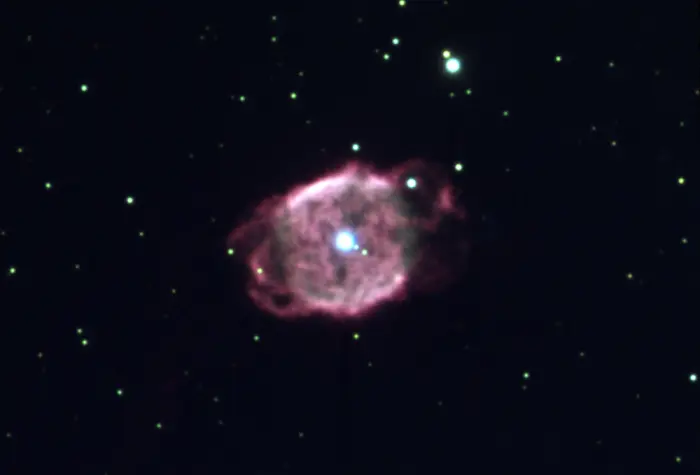
This is a combination of seven exposures through B, V and R filters taken in November of 1996 at the 3.5-meter WIYN telescope. Planetary nebula NGC40 is a low-excitation nebula in the constellation of Cepheus. The central star is fairly bright (about magnitude 11.6), has a mass of around 0.7 solar masses, and is much hotter than would be expected just from the properties of the surrounding nebula. This is because its temperature of around 90000 degrees should be hot enough to excite the nebula to a much higher ionization state than is found. This suggests the presence of shielding material between the star and the glowing nebula. Such higher density material could form in the shock interface between the fast wind (about 1800km/s) from the central star and the nebular shells themselves. The nebular material covers about 25% of the sky as viewed by the central star, implying rather asymmetric mass-loss from the star in its asymptotic giant branch stage. NGC40 has an extended halo, not seen here, probably caused by earlier mass ejection. Image credit: WIYN/NOIRLab/NSF (CC BY 4.0)
The nebula has a large halo, which consists of a diffuse inner halo attached to the main shell and an irregular filamentary halo that extends away from the central shell. The extended filamentary structure that surrounds the nebula likely formed when the central star was still a red giant on the asymptotic giant branch.
The morphological features of the Bow-Tie Nebula reflect the different stages of mass ejection from the central star. Like all planetary nebulae, NGC 40 formed when a low to intermediate-mass star evolved into an asymptotic giant branch (AGB) star and expelled large amounts of material into the circumstellar medium through dense stellar winds.
As the star reached the post-AGB phase, it developed fast winds and a strong ionising photon flux. The winds carved out an inner cavity and the UV flux photoionises the ejected material, producing a planetary nebula.
The Bow-Tie Nebula is surrounded by multiple filaments that lie in the background. These filaments are much further away and not associated with the nebula. They belong to the large supernova remnant CTA 1, which stretches across 1.5 degrees of the sky in the same line of sight.
Like all planetary nebulae, NGC 40 will eventually fade away as the nebular material drifts away into space and the central star cools. It will take about 30,000 years for the celestial Bow Tie to become invisible. The central star will become a white dwarf, a dense stellar remnant the size of the Earth.
The central star of NGC 40 is catalogued as HD 826 in the Henry Draper Catalogue and as HIP 1041 in the Hipparcos Catalogue. It has the spectral type [WC8], indicating the spectrum of a carbon-rich Wolf-Rayet star. The brackets are there to distinguish the star from Wolf-Rayet stars with the same classification. The central star of NGC 40 is a hydrogen-deficient star with strong lines of He, C and O, similar to the massive Wolf-Rayet stars of the WC type.
HD 826 has a radius about 56% that of the Sun and a bolometric luminosity of about 7,000 Suns. The star appears to have a surface temperature of 71,000 K. However, the source that ionizes NGC 40 has an effective temperature of only 45,000 K. Astronomers explain the discrepancy with a late thermal pulse that caused an ejection of carbon-rich material and an increase in the star’s temperature.
A 2019 study analysed infrared observations of the nebula with NASA’s Spitzer Space Telescope, the Canada–France–Hawaii Telescope (CFHT), and the Photodetector Array Camera and Spectrometer (PACS) on ESA’s Herschel Space Observatory. While mapping the distribution of the polycyclic aromatic hydrocarbons (PAHs) in the nebula, the astronomers found a toroidal structure that may be absorbing the ultraviolet flux from the central star, preventing the nebula from exhibiting high-excitation lines.
A 2022 study analysed the ionisation structure and kinematics of NGC 40 using images obtained with the ALhambra Faint Object Spectrograph and Camera (ALFOSC) at the Nordic Optical Telescope (NOT) and the High-resolution Manchester Echelle Spectrograph (MES) at the at 2.1m telescope of the San Pedro Mártir (SPM) Observatory. The researchers identified four jet-like ejections that are not aligned with the nebula’s main axis. At an adopted distance of 1.9 kiloparsecs, they found a kinematic age of 6,500 years for the main cavity and an age of 4,100 ± 550 years for the two pairs of lobes extending towards the north and south.
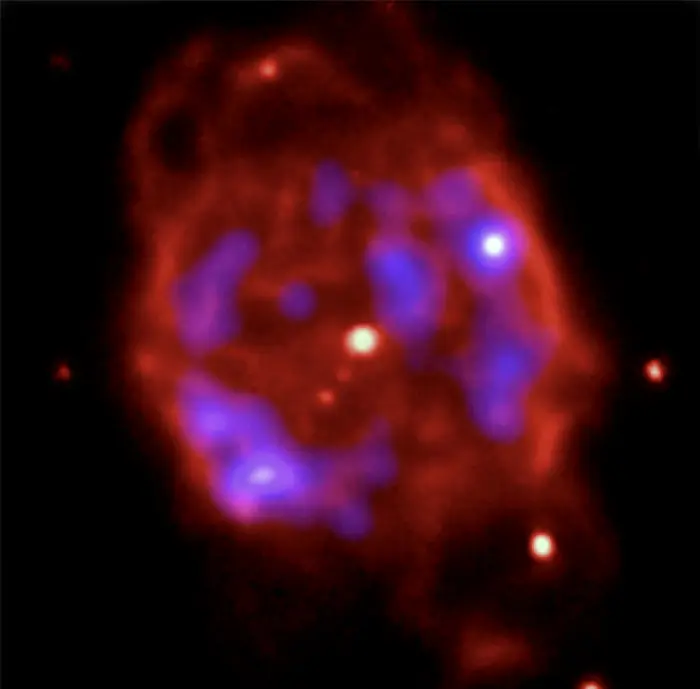
This composite X-ray (blue)/optical (red) image of the object NGC 40 shows hot gas around a Sun-like star. NGC 40 is one of a class of objects called planetary nebulae, so-called because they look like the disk of a planet when viewed with a small telescope. Radiation from the hot star heats the ejected matter to about 10,000 degrees to produce the complex and graceful nebula (red) about a light year across. The X-rays in the composite image reveal a shell of multimillion degree gas (blue) that has been compressed and heated by a 2-million-miles-per-hour stellar wind from the central star. Image credit – X-ray: NASA/CXC/RIT/J.Kastner & R.Montez.; Optical: NSF/AURA/NOAO/WIYN (CC BY 4.0)
Facts
The Bow-Tie Nebula was discovered by the German-born British astronomer William Herschel on November 25, 1788. Herschel spotted the object with his 18.7-inch telescope and described it as a “9th magnitude star, surrounded with milky nebulosity.”
In 1905, American astronomer Williamina Fleming identified NGC 40 as a planetary nebula.
The Bow-Tie Nebula is one of about a dozen planetary nebulae included in Sir Patrick Moore’s Caldwell catalogue of deep sky objects visible in amateur telescopes. Others include the Cat’s Eye Nebula (C6, NGC 6543) in the constellation Draco, the Blinking Planetary Nebula (NGC 6826, C15) in Cygnus, the Blue Snowball Nebula (NGC 7662, C22) in Andromeda, the Clown Face Nebula (NGC 2392, C39) in Gemini, the Saturn Nebula (NGC 7009, C55) and the Helix Nebula (NGC 7293, C63) in Aquarius, the Skull Nebula (NGC 246, C56) in Cetus, the Ghost of Jupiter Nebula (NGC 3242, C59) in Hydra, the Butterfly Nebula (NGC 6302, C69) in Scorpius, and the Southern Ring Nebula (NGC 3132, C74) in Vela.
NGC 40 is not to be confused with the planetary nebula ESO 172-7 (LEDA 3074547), better known as the Boomerang Nebula. The Boomerang Nebula is sometimes also called the Bow Tie. It lies 5,000 light-years away in the southern constellation Centaurus.
The Bow Tie Nebula also shares its nickname with the planetary nebula NGC 2440 in the constellation Puppis. NGC 2440 is also known as the Bow Nebula. It lies 4,000 light-years away and has an apparent magnitude of 9.4.
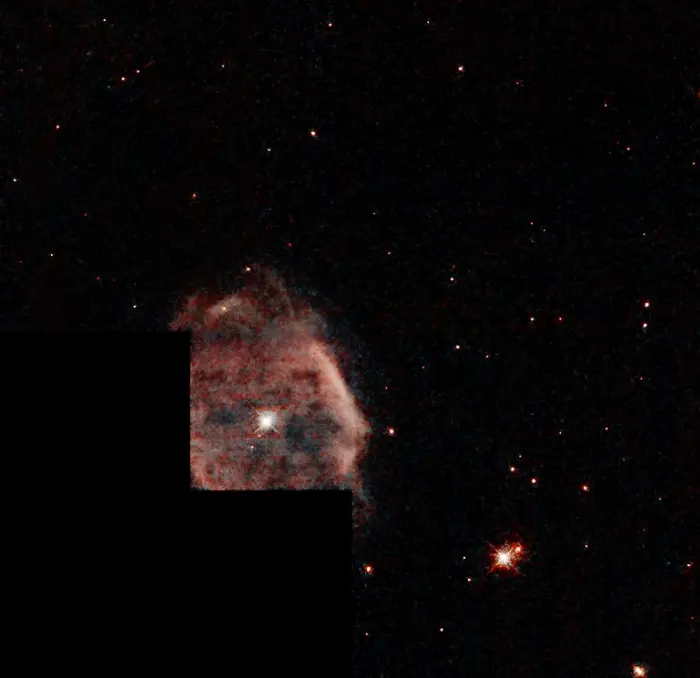
This hazy Hubble image captures a portion of the planetary nebula Caldwell 2, or NGC 40. A shell of gas is expanding outward from the nebula’s central star, which has reached the final stage of its life. Energy from the star is causing the surrounding shell of gas to glow. As the planetary nebula disperses over the course of tens of thousands of years, it will leave behind a stellar remnant called a white dwarf, the small, dense core of the star. Caldwell 2 is often difficult to spot because the glowing gas shell appears very small in the sky and has an apparent magnitude of only 12.3, making it the faintest object in the catalog. Caldwell 2’s bright central star can wash out the cloud of gas, so a telescope is needed to resolve the nebula. Observers in the northern hemisphere will have the best view of Caldwell 2 in early winter. The nebula can also be seen from equatorial latitudes in the southern hemisphere and is easiest to spot in early summer. This image of Caldwell 2 was taken in 1995 as part of a survey of nearby planetary nebulae. Astronomers used Hubble’s Wide Field and Planetary Camera 2 to search for central stars that have close companion stars. These companion stars are helpful to astronomers because they can be used to determine the distance to planetary nebulae like Caldwell 2. Credit: NASA, ESA, and H. Bond (Pennsylvania State University); Processing: Gladys Kober (NASA/Catholic University of America) (CC BY 2.0)
Location
The Bow-Tie Nebula lies in the far northern sky, only 17-18 degrees from the north celestial pole, in the region between the constellation figures of Cassiopeia (the Queen) and Cepheus (the King). The nebula appears about a quarter of the way from Errai (Gamma Cephei) to Achird (Eta Cassiopeiae).
Achird appears in the region of Cassiopeia’s W but is not part of the asterism. It is the brightest star near Schedar (Alpha Cassiopeiae), the bottom right star of the W and the brightest star in Cassiopeia.
Errai is an evolved red giant star located 44.98 light-years away. Shining at magnitude 3.21, it can be spotted from areas without too much light pollution. It sits at the top of the stick house asterism that dominates the constellation Cepheus.
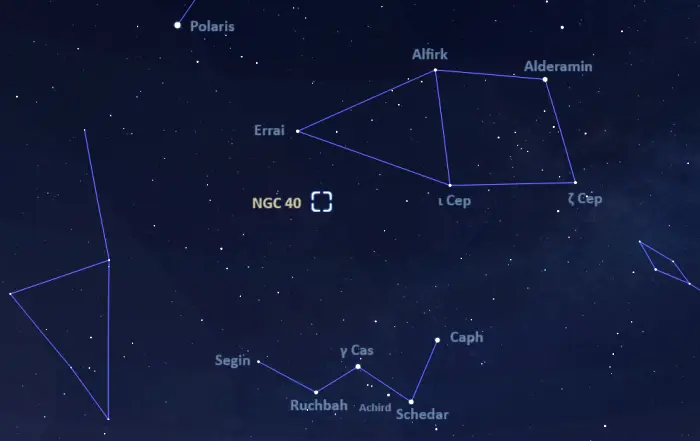
The location of the Bow-Tie Nebula (NGC 40), image: Stellarium
The Bow-Tie Nebula may be spotted in a 4-inch telescope in exceptionally good conditions. In small telescopes, it appears as a fuzzy star. In 8-inch telescopes at high magnification, it looks like an oval patch of light with a prominent central star. 12-inch and larger telescopes reveal some of the nebula’s knots and filaments.
At declination 72° N, NGC 40 is visible from locations north of the latitude 17° S, but it never rises high above the horizon for observers in the southern hemisphere.
Cepheus is circumpolar from most of the northern hemisphere and can be seen at any time of the year near Polaris. The best time to observe the Bow-Tie Nebula and other deep sky objects in Cepheus is during the months of October, November and December, when the constellation appears higher in the sky in the early evening.
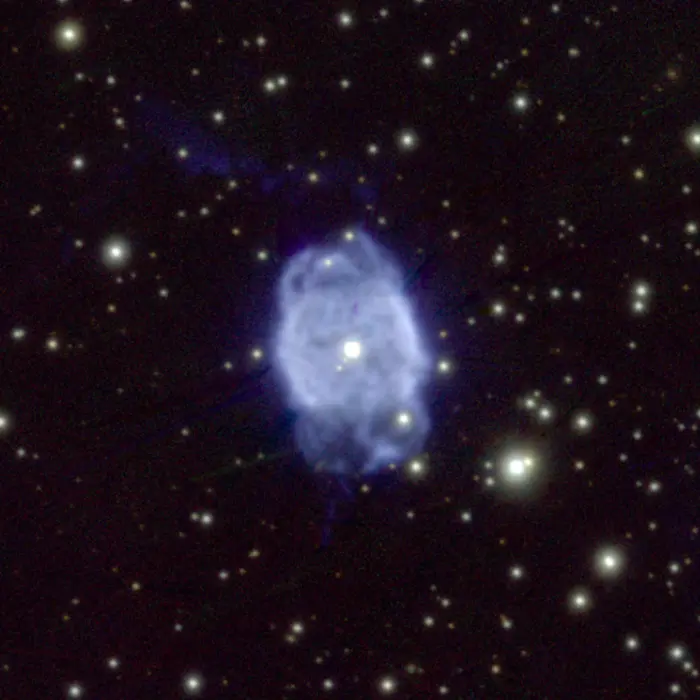
The Bow-Tie Nebula, image credit: Panoramic Survey Telescope and Rapid Response System (Pan-STARRS) (CC BY-SA 4.0)
Bow-Tie Nebula – NGC 40
| Constellation | Cepheus |
| Object type | Planetary nebula |
| Right ascension | 00h 13m 01.0170097248s |
| Declination | +72° 31′ 19.033338720″ |
| Apparent magnitude | 11.6 |
| Apparent size | 38″ × 35″ |
| Diameter | 1 light-year |
| Distance | 5,280 light-years (1,618 parsecs) |
| Names and designations | Bow-Tie Nebula, NGC 40, Caldwell 2, PN G120.0+09.8, PK 120+09 1, PN ARO 1, PN VV 1, PN VV’ 3, BWE 0010+7214, CSI+72-00102, HD 826, HIP 1041, GCRV 101, GSC 04302-01297, IRAS 00102+7214, 2MASS J00130099+7231190, TYC 4302-1297-1, Gaia DR2 537481007814722688, Gaia DR3 537481007814722688 |